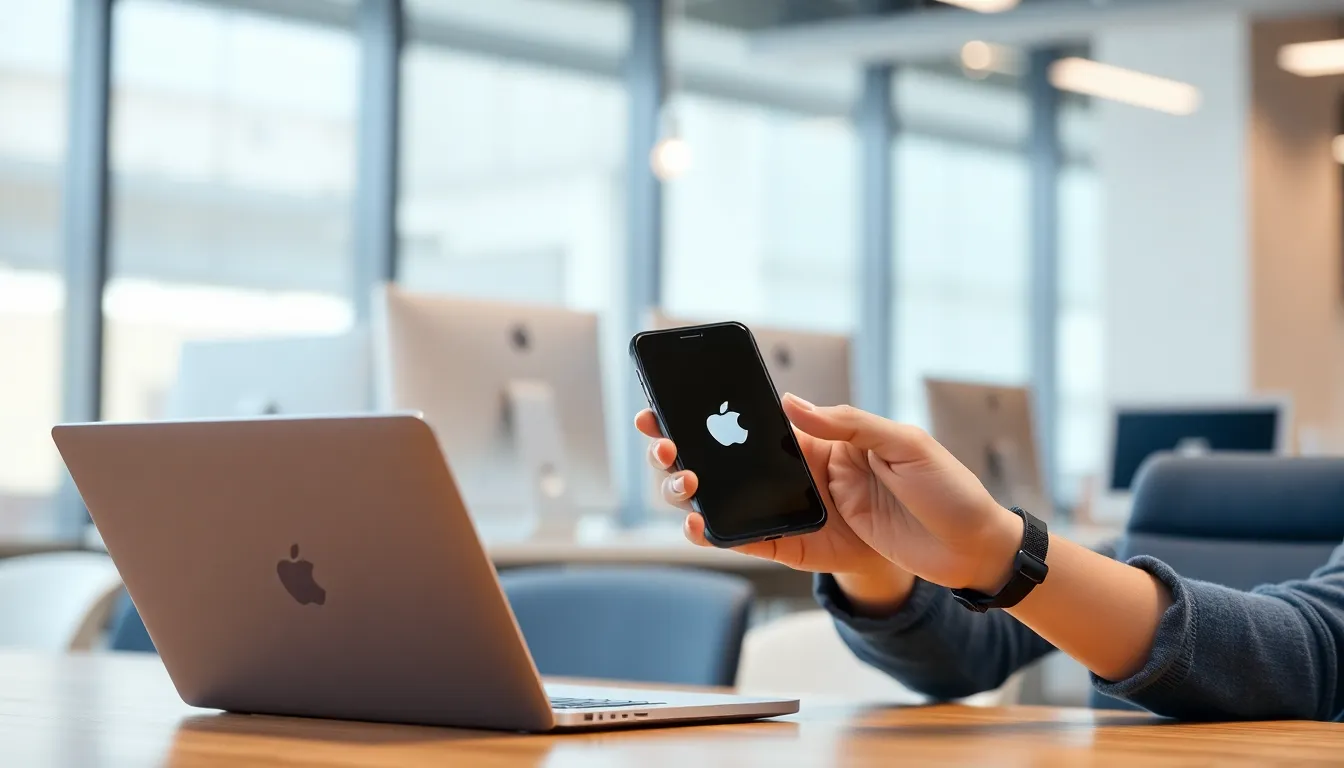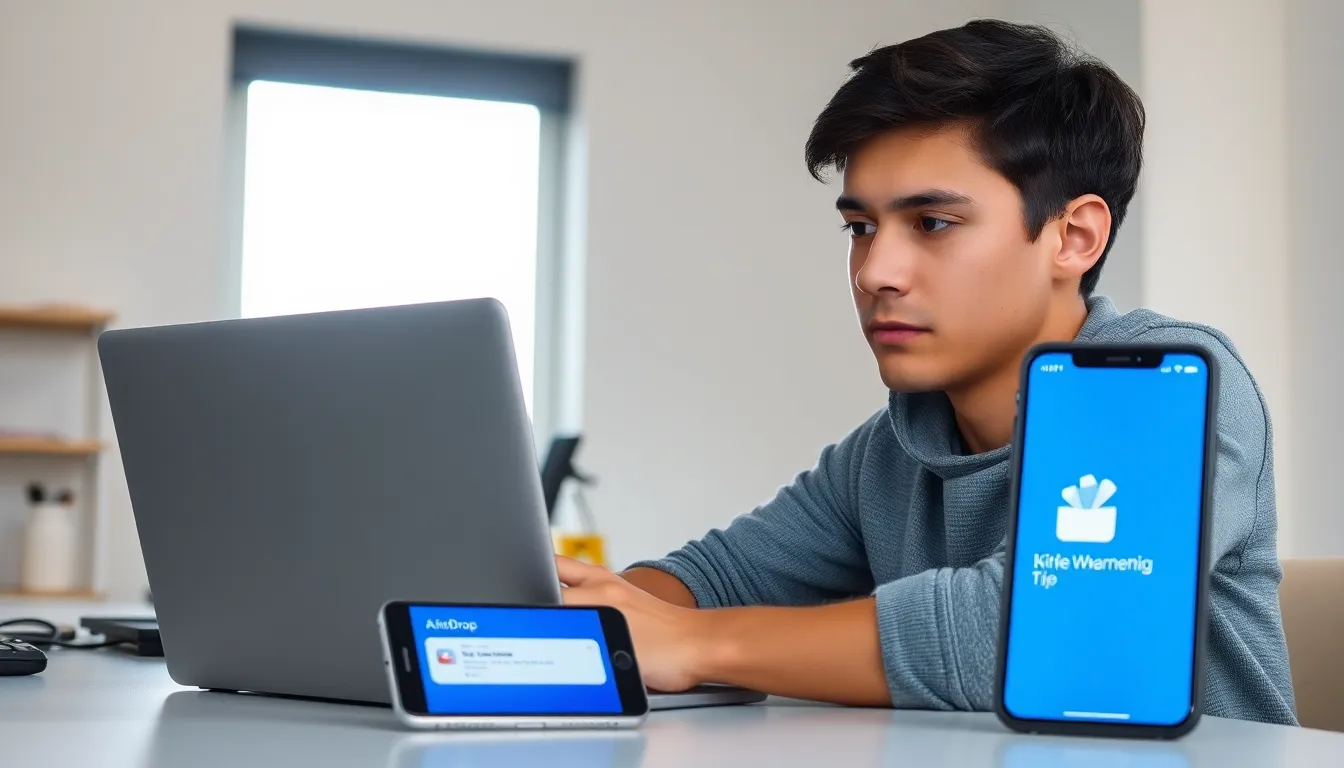Table of Contents
TogglePicture this: you’re sitting at your desk, ready to share that hilarious meme or important document from your Chromebook to your shiny iPhone. But wait—how on earth do you pull off this digital magic trick? While Apple’s AirDrop is a breeze for iPhone users, the Chromebook often feels like the awkward cousin at the family reunion.
Understanding AirDrop
AirDrop simplifies file sharing between Apple devices. This feature enables users to send photos, documents, and other files quickly and conveniently.
What Is AirDrop?
AirDrop is a feature created by Apple for iOS and macOS devices. Designed for quick local file transfers, it works without the need for internet or external apps. Users can share items wirelessly over Bluetooth and Wi-Fi. Devices that support AirDrop include iPhones, iPads, and Macs. Users appreciate the ease of selecting files and choosing nearby devices for transfer.
How It Works
AirDrop relies on Bluetooth for establishing a connection. When users enable AirDrop, their devices become discoverable to nearby Apple products. Once a connection occurs, Wi-Fi takes over to facilitate the file transfer. Files can be shared in seconds, depending on file size. Users can choose to adjust their AirDrop settings to control who can see their device. This flexibility ensures a secure and straightforward sharing experience.
Setting Up Your Chromebook

Setting up your Chromebook for file transfer to an iPhone requires a few specific adjustments. Users must ensure appropriate settings are configured for a seamless experience.
Required Settings
Adjusting settings on a Chromebook simplifies the process of airdropping to an iPhone. First, ensure Bluetooth is enabled by selecting the system tray and clicking the Bluetooth icon. Verify that the Wi-Fi connection is active, as this supports the transfer process. Users should also confirm that “Nearby Sharing” is turned on if available. Proximity is essential; devices need to be close to each other for successful file sharing.
Installing Necessary Extensions
Installing needed extensions enhances compatibility for Chromebook and iPhone interaction. Users can access the Chrome Web Store to find relevant options such as “Send to Phone” and “Pushbullet.” Both extensions facilitate quick file transfers between different devices. After installation, follow the prompts to register for an account, ensuring access to sharing features. Having these extensions set up reduces complications during the transfer process, making it an efficient experience.
Preparing Your iPhone
Preparing the iPhone for AirDrop requires a few straightforward steps. Users must enable specific settings to facilitate smooth file transfers.
Enabling AirDrop
First, swipe down from the top-right corner of the screen to access the Control Center. Then, press and hold the wireless control panel. When the AirDrop icon appears, tap it. Users can choose between “Receiving Off,” “Contacts Only,” or “Everyone.” Select “Everyone” for broader compatibility, particularly when receiving files from non-Apple devices. The choice allows devices to be discoverable by others nearby. It’s best to keep AirDrop active while completing file transfers.
Adjusting Privacy Settings
Next, navigate to the Settings app for privacy adjustments. Scroll down and select “General,” then tap on “AirDrop.” Users can adjust permissions related to who can send files. Choosing “Contacts Only” limits discoverability to known contacts. Opting for “Everyone” enables file sharing from all nearby devices, enhancing transfer opportunities. Always consider the implications of these settings for personal privacy. Once adjustments are made, the iPhone is ready for successful file sharing with other devices.
Step-by-Step Guide to AirDrop
Transferring files from a Chromebook to an iPhone involves specific steps. Follow these instructions carefully for a seamless process.
AirDropping Files from Chromebook
Start by opening the file you want to share on the Chromebook. Choose the “Send to” option, which may be available in the file context menu. Select “Nearby Sharing” or a compatible extension like “Send to Phone” or “Pushbullet”. Ensure Bluetooth is activated on both devices. After choosing the recipient device, send the file. A notification will appear, indicating the transfer is in progress. Once completed, a confirmation message should display, signaling a successful transfer to the iPhone.
Receiving Files on iPhone
Prepare the iPhone by accessing the Control Center. Swipe down from the top-right corner and hold the wireless control panel to enable AirDrop. Opt for “Everyone” to ensure compatibility with Chromebook sharing. Look for an alert indicating an incoming file transfer. Accept the transfer by clicking on the notification that appears. The file will automatically download to the appropriate application based on its type. Files such as images will directly go to the Photos app, while documents may open in their respective applications.
Troubleshooting Common Issues
Transferring files from a Chromebook to an iPhone may present challenges. Various common issues can impede successful transfers.
Connection Problems
Connection problems often stem from inactive Bluetooth or Wi-Fi settings. Bluetooth must be enabled on both devices to facilitate discovery and communication. Confirming Wi-Fi is active on the Chromebook helps maintain an efficient transfer. A close proximity between devices further enhances connectivity. If the devices don’t see each other, restarting both the Chromebook and the iPhone may resolve temporary glitches. Users should also verify that their “Nearby Sharing” feature is enabled as this can affect visibility. Occasionally, switching to AirDrop settings on the iPhone might require toggling between “Contacts Only” and “Everyone” to establish a secure connection.
File Compatibility
File compatibility issues frequently arise when users attempt to transfer incompatible file types. Chromebooks can handle various formats, but iPhones only accept specific types like images, documents, and audio files. Understanding which formats are supported helps streamline file sharing. For example, JPEG images and PDF documents transfer smoothly, while files like .exe or unsupported video formats won’t work. Users should ensure that files intended for sharing meet the iOS criteria. Checking the file type before initiating the transfer saves time and frustration. Additionally, using supported extensions, such as “Send to Phone” or “Pushbullet,” aids in identifying and managing compatible formats effectively.
Transferring files from a Chromebook to an iPhone doesn’t have to be a daunting task. With the right setup and tools, users can enjoy a seamless sharing experience. Enabling Bluetooth and Wi-Fi while utilizing extensions like “Send to Phone” or “Pushbullet” can significantly simplify the process.
By adjusting AirDrop settings on the iPhone and ensuring proximity between devices, users can facilitate smooth file transfers. Troubleshooting common issues like connectivity problems and file compatibility can further enhance the experience. Adopting these strategies allows users to bridge the gap between their Chromebook and iPhone effortlessly.





